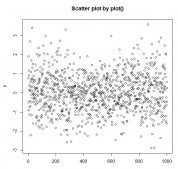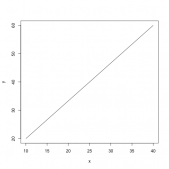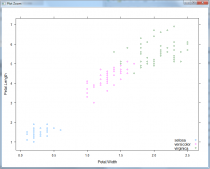在R語言中的單引號或雙引號對中寫入的任何值都被視為字符串。 R語言存儲的每個字符串都在雙引號內(nèi),即使是使用單引號創(chuàng)建的依舊如此。
在字符串構(gòu)造中應(yīng)用的規(guī)則
- 在字符串的開頭和結(jié)尾的引號應(yīng)該是兩個雙引號或兩個單引號。它們不能被混合。
- 雙引號可以插入到以單引號開頭和結(jié)尾的字符串中。
- 單引號可以插入以雙引號開頭和結(jié)尾的字符串。
- 雙引號不能插入以雙引號開頭和結(jié)尾的字符串。
- 單引號不能插入以單引號開頭和結(jié)尾的字符串。
有效字符串的示例
以下示例闡明了在 R 語言中創(chuàng)建字符串的規(guī)則。
|
1
2
3
4
5
6
7
8
9
10
11
|
a <- 'Start and end with single quote'print(a)b <- "Start and end with double quotes"print(b)c <- "single quote ' in between double quotes"print(c)d <- 'Double quotes " in between single quote'print(d) |
當(dāng)運(yùn)行上面的代碼,我們得到以下輸出
|
1
2
3
4
|
[1] "Start and end with single quote"[1] "Start and end with double quotes"[1] "single quote ' in between double quote"[1] "Double quote " in between single quote" |
無效字符串的示例
|
1
2
3
4
5
6
7
8
|
e <- 'Mixed quotes" print(e)f <- 'Single quote ' inside single quote'print(f)g <- "Double quotes " inside double quotes"print(g) |
當(dāng)我們運(yùn)行腳本失敗給下面的結(jié)果。
|
1
2
3
4
5
6
7
|
...: unexpected INCOMPLETE_STRING.... unexpected symbol 1: f <- 'Single quote ' insideunexpected symbol1: g <- "Double quotes " inside |
字符串操作
連接字符串 - paste() 函數(shù)
R語言中的許多字符串使用 paste() 函數(shù)組合。 它可以采取任何數(shù)量的參數(shù)組合在一起。
語法
對于粘貼功能的基本語法是
|
1
|
paste(..., sep = " ", collapse = NULL) |
以下是所使用的參數(shù)的說明 -
- ... 表示要組合的任意數(shù)量的自變量。
- sep 表示參數(shù)之間的任何分隔符。它是可選的。
- collapse 用于消除兩個字符串之間的空格。 但不是一個字符串的兩個字內(nèi)的空間。
例
|
1
2
3
4
5
6
7
8
9
|
a <- "Hello"b <- 'How'c <- "are you? "print(paste(a,b,c))print(paste(a,b,c, sep = "-"))print(paste(a,b,c, sep = "", collapse = "")) |
當(dāng)我們執(zhí)行上面的代碼,它產(chǎn)生以下結(jié)果
|
1
2
3
|
[1] "Hello How are you? "[1] "Hello-How-are you? "[1] "HelloHoware you? " |
格式化數(shù)字和字符串 - format() 函數(shù)
可以使用 format() 函數(shù)將數(shù)字和字符串格式化為特定樣式。
語法
格式化函數(shù)的基本語法是
|
1
|
format(x, digits, nsmall, scientific, width, justify = c("left", "right", "centre", "none")) |
以下是所使用的參數(shù)的描述 -
- x 是向量輸入。
- digits 是顯示的總位數(shù)。
- nsmall 是小數(shù)點(diǎn)右邊的最小位數(shù)。
- 科學(xué)設(shè)置為 TRUE 以顯示科學(xué)記數(shù)法。
- width 指示通過在開始處填充空白來顯示的最小寬度。
- justify 是字符串向左,右或中心的顯示。
例
|
1
2
3
4
5
6
7
8
9
10
11
12
13
14
15
16
17
18
19
20
21
22
23
24
25
26
27
|
# Total number of digits displayed. Last digit rounded off.result <- format(23.123456789, digits = 9)print(result)# Display numbers in scientific notation.result <- format(c(6, 13.14521), scientific = TRUE)print(result)# The minimum number of digits to the right of the decimal point.result <- format(23.47, nsmall = 5)print(result)# Format treats everything as a string.result <- format(6)print(result)# Numbers are padded with blank in the beginning for width.result <- format(13.7, width = 6)print(result)# Left justify strings.result <- format("Hello", width = 8, justify = "l")print(result)# Justfy string with center.result <- format("Hello", width = 8, justify = "c")print(result) |
當(dāng)我們執(zhí)行上面的代碼,它產(chǎn)生以下結(jié)果 -
|
1
2
3
4
5
6
7
|
[1] "23.1234568"[1] "6.000000e+00" "1.314521e+01"[1] "23.47000"[1] "6"[1] " 13.7"[1] "Hello "[1] " Hello " |
計算字符串中的字符數(shù) - nchar() 函數(shù)
此函數(shù)計算字符串中包含空格的字符數(shù)。
語法
nchar() 函數(shù)的基本語法是
|
1
|
nchar(x) |
以下是所使用的參數(shù)的描述 -
x 是向量輸入。
例
|
1
2
|
result <- nchar("Count the number of characters")print(result) |
當(dāng)我們執(zhí)行上面的代碼,它產(chǎn)生以下結(jié)果
|
1
|
[1] 30 |
更改case - toupper()和tolower()函數(shù)
這些函數(shù)改變字符串的字符的大小寫。
語法
toupper()和tolower()函數(shù)的基本語法是
|
1
2
|
toupper(x)tolower(x) |
以下是所使用的參數(shù)的描述 -
x是向量輸入。
例
|
1
2
3
4
5
6
7
|
# Changing to Upper case.result <- toupper("Changing To Upper")print(result)# Changing to lower case.result <- tolower("Changing To Lower")print(result) |
當(dāng)我們執(zhí)行上面的代碼,它產(chǎn)生以下結(jié)果
提取
|
1
2
|
[1] "CHANGING TO UPPER"[1] "changing to lower" |
字符串的一部分 - substring()函數(shù)
此函數(shù)提取字符串的部分。
語法
substring() 函數(shù)的基本語法是
|
1
|
substring(x,first,last) |
以下是所使用的參數(shù)的描述 -
- x 是字符向量輸入。
- 首先是要提取的第一個字符的位置。
- last 是要提取的最后一個字符的位置。
例
|
1
2
3
|
# Extract characters from 5th to 7th position.result <- substring("Extract", 5, 7)print(result) |
當(dāng)我們執(zhí)行上面的代碼,它產(chǎn)生以下結(jié)果
|
1
|
[1] "act" |
到此這篇關(guān)于R語言字符串知識點(diǎn)總結(jié)及實例分析的文章就介紹到這了,更多相關(guān)R語言字符串內(nèi)容請搜索服務(wù)器之家以前的文章或繼續(xù)瀏覽下面的相關(guān)文章希望大家以后多多支持服務(wù)器之家!
原文鏈接:https://www.w3cschool.cn/r/r_data_reshaping.html















